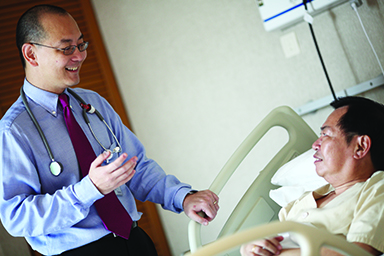NUHS Institutions will NEVER ask you to transfer money or disclose bank details over a call.
If in doubt, call the 24/7 ScamShield helpline at 1799, or visit the ScamShield website at www.scamshield.gov.sg.
Paediatric Cancers are different from cancers in adults. The most common Paediatric Cancers are:
The common adult cancers (e.g. lung cancer, colon cancer) are very rare in children.
Leukaemia is commonly thought to be a blood cancer, but its origin is in the bone marrow cells which are normally programmed to mature into blood cells. Leukaemia happens when one of the cells undergoes genetic changes (which are entirely “accidental” and unpredictable) which enable the cells to undergo unrestrained proliferation. Eventually, the Leukaemia cells overwhelm the normal cells in the bone marrow, such that the marrow is unable to perform its normal function (producing mature red blood cells, white blood cells and platelets). The Leukeamia cells also escape into the blood and infiltrate other organs (especially the lymph nodes, liver and spleen).
Leukaemia accounts for about 40% of all childhood cancers in Singapore and throughout the world. Luckily, there have been significant advances in the therapy of childhood Leukaemia in Singapore so much so that more than 80% of these children are now long-term survivors and are considered cured.
Leukaemia can be classified into acute (rapidly developing) and chronic (slowly developing) forms. In children, 98% of Leukaemia is acute.
Depending on which cell line (mother cell) the Leukaemia started from, acute childhood Leukaemia is divided into:
Acute Lymphoblastic Leukaemia (ALL) most commonly afflicts younger children from ages 2 to 8, with a peak incidence at age 4. But it can affect all age groups.
In majority of the cases, the cause of Leukaemia is unknown. Leukaemia develops from non-inherited mutations (changes) in the genes of young bone marrow cells.
As part of research efforts in the NCIS, we have been studying the risk profiles of children with Leukaemia to allow us to predict the risk of developing childhood Leukaemia, their chances of cure and complications from therapy. This is funded by the National Medical Research Council, Children’s Cancer Foundation and Viva Foundation for Children with Cancer.
While the risk of many adult cancers can be reduced by lifestyle changes (e.g. quitting smoking), there is currently no known way to prevent Childhood Leukaemia. Majority of adults and children diagnosed with Leukaemia have no known risk factors, so there is no known way to prevent Leukaemia from developing.
Physical Examination
A physical examination will be performed to check for signs of infection, anaemia, abnormal bleeding, and swollen lymph nodes. The child’s abdomen is also examined to see if there is an enlarged liver or spleen. This can occur with some cancers in children.
In addition medical history of the family will be taken and FBC taken (full blood count) to measure the numbers of white cells, red cells, and platelets in the child's blood. A blood smear will also be taken to check for certain specific types of abnormal blood cells.
From the results of the physical examination and preliminary blood tests, further tests like those below may be needed.
Bone Marrow Biopsy & Aspiration
Bone marrow samples are removed from the body (usually from the back of the hip bone) for testing.
At the NCIS, we have a highly comprehensive panel of routine and investigational tests that can help diagnose, subgroup and prognosticate the type of Leukaemia with exceedingly high accuracy. It is critical to know the biology of the Leukaemia so that we are able to track the response and accurately tailor our treatment to optimise the response.
Your child may need a repeat bone marrow examination in the NCIS when he/she is seen here.
Lumbar Puncture (Spinal Tap)
During a lumbar puncture (spinal tap), a sample of spinal fluid is removed from the lower back and examined for evidence of abnormal cells. This is to determine if the Leukaemia has spread to the central nervous system (brain and spinal cord).
Bone marrow or lymph node samples will be examined and additional testing will be done to determine the specific type of Leukaemia. In addition to these basic laboratory tests, cell evaluations are also generally done, including genetic studies to distinguish between specific types of Leukaemia, as well as certain features of the Leukaemia cells. For painful procedures, the child will receive anesthesia or sedative medications.
The goal in treatment for Acute Myeloid Leukaemia (AML) and Acute Lymphoblastic Leukaemia (ALL) is to kill all the leukemia cells in the body.
We have been running clinical trials for treatment of these Leukaemias, and our paediatric research laboratory is able to perform the necessary advanced tests (including analysing the genetic abnormalities in the Leukaemia cells) to characterise the Leukaemia cells and thus allow us to customise the therapy to suit individual patients.
Chemotherapy
To decrease the chance of Leukaemia invading the central nervous system, patients receive intrathecal chemotherapy, which administers cancer-killing drugs into the cerebrospinal fluid around the brain and spinal cord. Radiation treatments to eradicate Leukaemia in the brain may also be used for certain high-risk patients. During this period, close monitoring by a paediatric oncologist is imperative. Intensive Leukaemia chemotherapy may incur side effects like hair loss, nausea and vomiting. As treatment progresses, the cancer treatment team will monitor the child closely for those side effects.
Once remission is achieved, maintenance chemotherapy is then used to keep the child in remission. This is given in cycles over a period of 2 to 3 years to keep the cancer from recurring. Leukaemia will almost always relapse (re-occur) if this additional chemotherapy isn't given. There are also cases when the cancer returns even though maintenance chemotherapy is given, and other forms of chemotherapy will then be necessary.
Bone Marrow Transplant
In some instances, a bone marrow transplant may be necessary in addition to, or instead of chemotherapy, depending on the type of Leukaemia a child has. Healthy bone marrows are injected into the child’s body during the transplant.
With the proper treatment, the outlook for children who are diagnosed with Leukaemia is excellent. Childhood ALL has >98% remission rate after 1 month of therapy and > 80% are cured with our current protocols.
The cure rates for AML used to be rather poor, but recently, with improved drug therapy (including cellular therapy for some patients) and supportive care, ~60% of children with AML are curable under our recent research protocol.

Paediatric Cancer Care Approach

Paediatric Cancer Care Team

Paediatric Cancer Online Resource Library

Patient Support Groups

Paediatric Cancer Clinical Trials